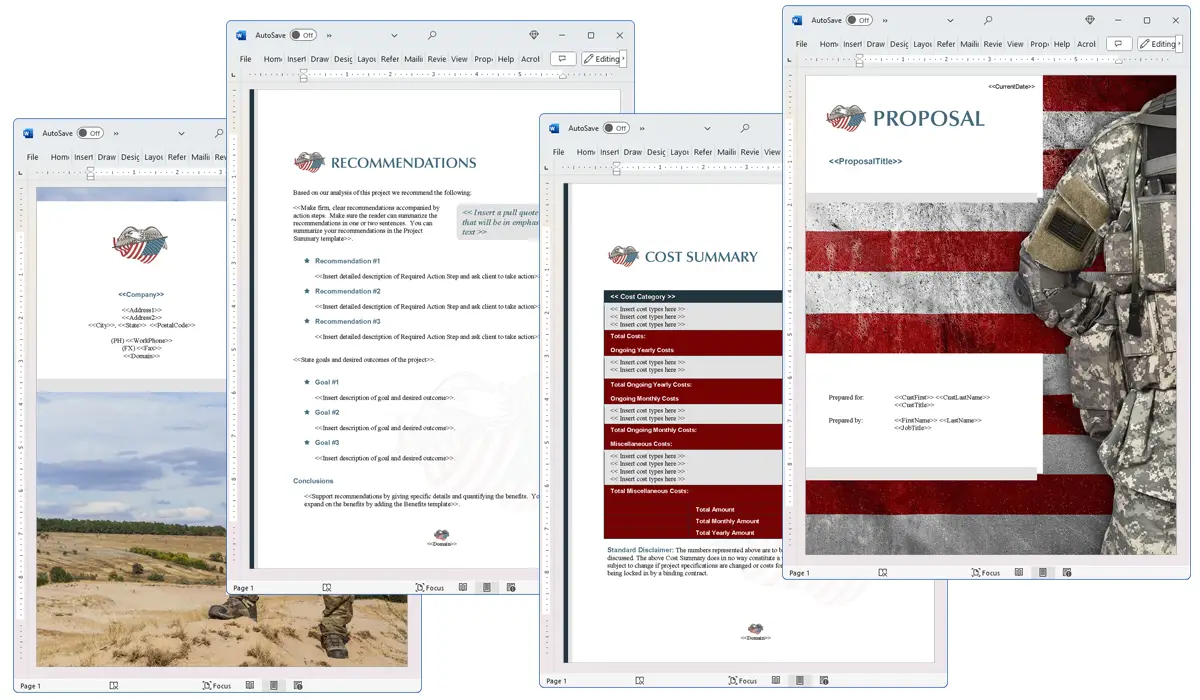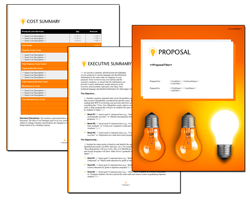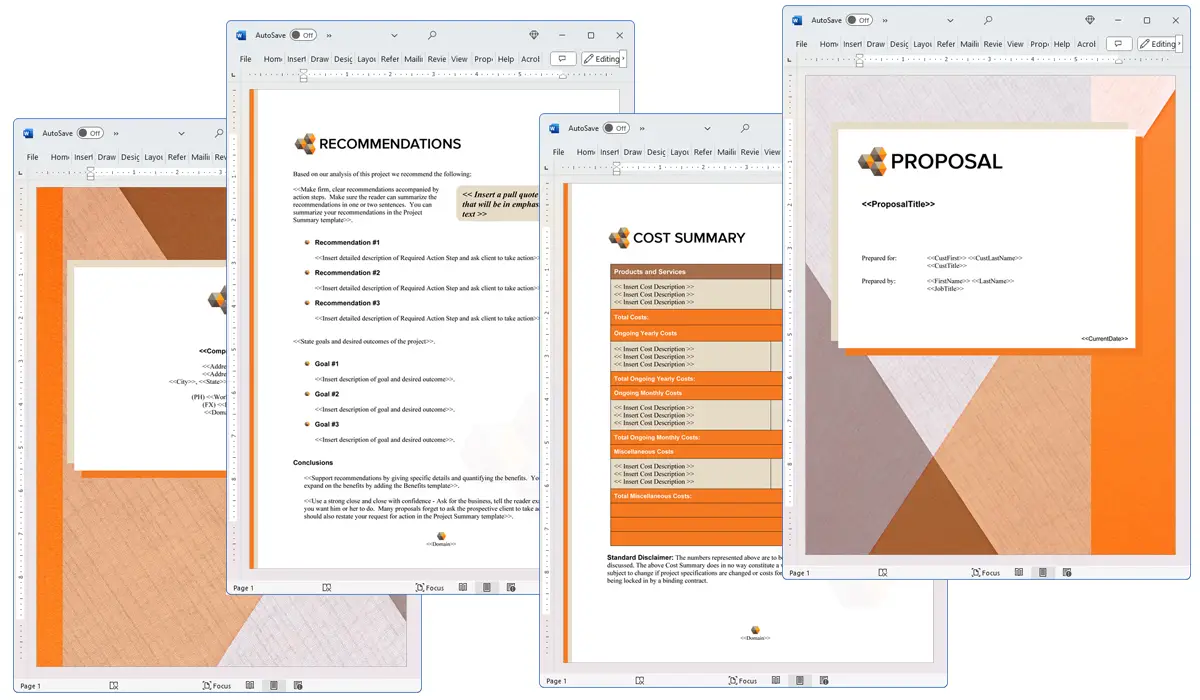What is the Financial Information chapter used for?
Proposal Kit Professional Bundle adds more design themes, all six Contract Packs,
a project management library, and Expert Edition software.

Illustration of Proposal Pack Military #5
We include this Financial Information chapter template in every Proposal Pack, along with thousands more. You assemble this chapter with others in various combinations to create custom-tailored business proposals, plans, reports, and other documents. Proposal Packs apply custom visual designs to the templates, giving the final documents a consistent professional finish.
 DOWNLOADABLE, ONE-TIME COST, NO SUBSCRIPTION FEES
DOWNLOADABLE, ONE-TIME COST, NO SUBSCRIPTION FEES
Overview of the Financial Information Chapter
The Financial Information chapter is an important component in the structure of a business proposal. This chapter serves as a concise summary that outlines key financial details and statistics relevant to the proposal at hand. In a business context, presenting financial data clearly and accurately is crucial as it helps in establishing credibility and persuading potential investors or partners about the viability and profitability of a project or business.
How is the Financial Information Chapter Used?
In a business proposal, the Financial Information chapter is used to communicate important financial facts to the recipient. This could be current financial status, projections, budgets, or financial requests. It acts as a snapshot, providing a quick overview of financial health or needs, which can be elaborated on with more detailed chapters or annexed documents if necessary. Typically, this chapter is placed in a proposal to ensure that decision makers can easily access and understand the financial implications of the proposal.
What is Included in the Financial Information Chapter?
The Financial Information chapter typically includes several key elements:
- Current Financial Status: Outlines existing financial resources, revenue streams, and profitability.
- Financial Projections: Estimates of future income, expenses, and profitability over a specified period.
- Budget Requirements: Details of the funds needed for the project, including breakdowns of costs.
- Funding Requests: Specific funding needs from investors or lenders, including desired terms.
- Financial Summary: A high-level recap of all financial data presented, highlighting the most critical points.
Use Case Examples for the Financial Information Chapter
- Startup Business Proposals: For new companies seeking investment, detailing startup costs, capital requirements, and projected cash flow.
- Grant Applications: Outlining how funds will be used, and expected financial impact of the grant.
- Business Expansion Proposals: Showing projected financial outcomes from expansion, such as increased revenue and costs.
- Loan Applications: Summarizing financial health to secure a loan, showing ability to meet repayment terms.
- Partnership Proposals: Illustrating financial contributions and expected benefits for all parties involved.
Key Takeaways
- The Financial Information chapter is important for summarizing crucial financial details in a business proposal.
- It provides a snapshot of financial status, projections, and needs that is integral for decision making.
- This chapter includes current financial data, projections, budgets, and specific funding requests.
- Effective use of the Financial Information chapter can significantly influence the success of a proposal.
- It is adaptable to various proposal types, including grants, loans, partnerships, and more, making it universally applicable in many business scenarios.

Illustration of Proposal Pack Concepts #16
 What Our Clients Say
What Our Clients SayProposal Kit has helped me to organize and prioritize my presentation/proposals. I have used it many times and have secured several projects. I am using it to secure projects and financial backing in agricultural product R&D."
 4.7 stars, based on 849 reviews
4.7 stars, based on 849 reviewsRelated Chapters
- Budget
- Balance Sheet
- Income Projection
- Breakeven Analysis
- Profit and Loss Statement
- Accounting
- Hourly Rates
- Payroll
- Sarbanes-Oxley Compliance
- Bankruptcy
- Funding Plan
- Reserves
- Initial Public Offering
- Debt Service Coverage
- Financial Support
- Business Model
- Fundamentals
- Defaults
- Burn Rate
- Deficit
- General Fund
- Discretionary Funds
Samples Using the Financial Information Chapter
Document Layouts Using the Financial Information Chapter
- Real Estate Resort Development Sales Proposal
- Merger of Companies Proposal
- Business Model Change Planning Rolling Shutdowns Proposal
- Transitional Housing Funding Proposal
- Business Selling Shares of Company Proposal
- Vocational Job Training for Youth Proposal
- DOJ Federal Government Grant Proposal
- Enhancing Border Security Proposal Template
- HHS Federal Government Grant Proposal
- Placement Hiring for IT Services Proposal
- Daycare Preschool Grant Funding Proposal
- Border Patrol Expansion Proposal Template
- Meals To Go Service Proposal Template
- Ranching Investment Funding Proposal
- Commercial Property Management Proposal Template
- Daycare Proposal Template
- Elevator and Escalator Sales and Service Proposal
- Services RFP Response Proposal
- Ranch Business Plan Funding Proposal
- Food Kiosk Equipment Grant Proposal
- And more like these

The Financial Information chapter and other chapters are integrated into a Word document as illustrated here in the Proposal Pack Contemporary #18 design theme. There are hundreds of design themes available, and every design theme includes the Financial Information chapter template.
A proper business proposal will include multiple chapters. This chapter is just one of many you can build into your proposal. We include the complete fill-in-the-blank template in our Proposal Pack template collections. We also include a library of sample proposals illustrating how companies in different industries, both large and small, have written proposals using our Proposal Packs. This template will show you how to write the Financial Information.
We include a chapter library for you to build from based on your needs. All proposals are different and have different needs and goals. Pick the chapters from our collection and organize them as needed for your proposal.
Using the Proposal Pack template library, you can create any business proposal, report, study, plan, or document.
The Wizard software includes an AI Writer, which will write the content of this and any other chapter of your document. Use the AI Writer to do the heavy lifting, writing the first draft of your proposal or business document in minutes.
 Ian Lauder has been helping businesses write their proposals and contracts for two decades. Ian is the owner and founder of Proposal Kit, one of the original sources of business proposal and contract software products started in 1997.
Ian Lauder has been helping businesses write their proposals and contracts for two decades. Ian is the owner and founder of Proposal Kit, one of the original sources of business proposal and contract software products started in 1997.By Ian Lauder
 Published by Proposal Kit, Inc.
Published by Proposal Kit, Inc.


 Cart
Cart
 Facebook
Facebook YouTube
YouTube Bluesky
Bluesky Search Site
Search Site